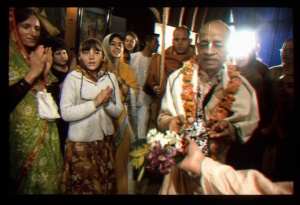CC Madhya 20.246 (1975)

A.C. Bhaktivedanta Swami Prabhupada
Below is the 1996 edition text, ready to be substituted with the 1975 one using the compile form.
TEXT 246
- guṇāvatāra, āra manvantarāvatāra
- yugāvatāra, āra śaktyāveśāvatāra
SYNONYMS
guṇa-avatāra—the incarnations who control the material qualities; āra—also; manu-antara-avatāra—the incarnations associated with the reign of each Manu; yuga-avatāra—the incarnations according to different yugas; āra—and; śakti-āveśa-avatāra—empowered incarnations.
TRANSLATION
“There are incarnations that control the material qualities [guṇa-avatāras], incarnations associated with the reign of each Manu [manvantara-avatāras], incarnations in different millenniums [yuga-avatāras] and incarnations of empowered living entities [śaktyāveśa-avatāras].
PURPORT
The guṇa-avatāras are three—Lord Brahmā, Lord Śiva and Lord Viṣṇu (SB 10.88.3). The avatāras associated with the reign of each Manu, known as manvantara-avatāras, are listed as follows in Śrīmad-Bhāgavatam (Eighth Canto, chapters 1, 5 and 13): (1) Yajña, (2) Vibhu, (3) Satyasena, (4) Hari, (5) Vaikuṇṭha, (6) Ajita, (7) Vāmana, (8) Sārvabhauma, (9) Ṛṣabha, (10) Viṣvaksena, (11) Dharmasetu, (12) Sudhāmā, (13) Yogeśvara and (14) Bṛhadbhānu. All together these are fourteen in number, and of these, Yajña and Vāmana are also counted among the līlā-avatāras. All these manvantara incarnations are sometimes called vaibhava-avatāras.
The four yuga-avatāras are (1) śukla (white) in Satya-yuga (SB 11.5.21), (2) rakta (red) in Tretā-yuga (SB 11.5.24), (3) śyāma (dark blue) in Dvāpara-yuga (SB 11.5.27) and (4) generally kṛṣṇa (black) but in special cases pīta (yellow) as Caitanya Mahāprabhu in Kali-yuga (SB 11.5.32 and SB 10.8.13).
The śaktyāveśa-avatāras are categorized into (1) forms of divine absorption (bhagavad-āveśa), such as Kapiladeva or Ṛṣabhadeva, and (2) divinely empowered forms (śaktyāveśa), of whom seven are foremost: (1) Śeṣa Nāga in the Vaikuṇṭha world, empowered for the personal service of the Supreme Lord (sva-sevana-śakti), (2) Anantadeva, empowered to bear all the planets within the universe (bhū-dhāraṇa-śakti), (3) Lord Brahmā, empowered with the energy to create the cosmic manifestation (sṛṣṭi-śakti), (4) Catuḥsana, or the Kumāras, specifically empowered to distribute transcendental knowledge (jñāna-śakti), (5) Nārada Muni, empowered to distribute devotional service (bhakti-śakti), (6) Mahārāja Pṛthu, specifically empowered to rule and maintain the living entities (pālana-śakti) and (7) Paraśurāma, specifically empowered to cut down rogues and demons (duṣṭa-damana-śakti).